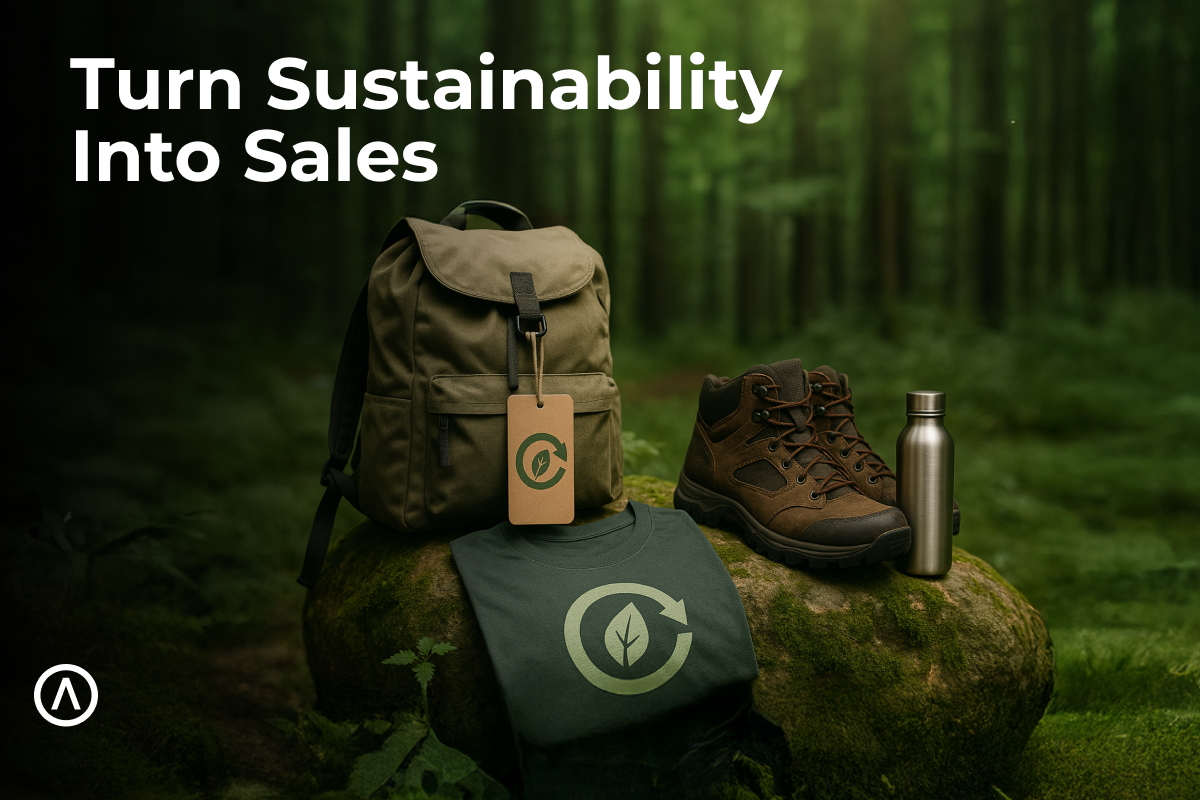
Sustainable Outdoor Marketing: How Eco‑Conscious Positioning Drives Sales in 2025
Why sustainability is the new baseline in outdoor marketing
Outdoor participation is booming, and shoppers are more conscious than ever about what they buy and why. In 2025, sustainable outdoor marketing isn’t just a trend—it’s a baseline expectation. Brands that fail to meet it risk losing market share to competitors who can prove their eco-credentials.
Today’s consumers demand both performance and responsibility. Deloitte reports that 46% of shoppers purchased at least one sustainable product in April 2023, even during inflationary pressure. PwC adds that they’re willing to pay nearly 10% more on average for sustainable goods. Combine that with the fact that outdoor gear is built for durability, and the opportunity is clear: sustainability sells, and credibility drives long-term growth.
This guide explores how outdoor brands can position themselves for success, from Amazon’s Climate Pledge Friendly (CPF) program to building transparent product pages, leveraging reviews, and executing a 30/60/90-day roadmap for sustainable growth.
Key Takeaways
- Demand exists: buyers still pay more for sustainable products (average ~9.7% premium).
- Credibility wins: use recognized certifications + transparent claims.
- Leverage Amazon’s Climate Pledge Friendly (CPF) to improve discovery.
- Tell the performance story (durability, repairability, materials) with A+ and video.
- Measure properly with AMC (NTB, path‑to‑purchase, halo).
Why does eco-conscious positioning matter in 2025?
Answer: Shoppers continue to prioritize sustainability even amid inflation—46% bought at least one sustainable good in April 2023 across 23 countries, showing durable demand. (Deloitte)
PwC’s 2024 survey shows consumers are willing to pay ~9.7% more for sustainable products on average.
Meanwhile, outdoor participation remains historically high—meaning more potential customers for eco‑positive gear. (OIA Outdoor Participation Trends Report)
Which sustainability signals actually move the needle on Amazon?
Climate Pledge Friendly (CPF): a label for products with one or more of 55 recognized certifications, helping shoppers discover more sustainable options. Amazon News
Examples include EPA Safer Choice and Rainforest Alliance—Amazon partners to highlight such standards.
Pro tip: Make your CPF badge visible in images/A+ and echo the certification in bullets (no unverifiable claims).
How do we make claims credible (and avoid greenwashing)?
- Use verified third-party certifications.
- Quantify impact where possible.
- Keep claims specific (materials, durability, repairability).
Mainstream guidance urges buyers to look for verifiable standards—lean into that with transparent PDPs, linkable proof, and even customer reviews that mention eco-features. Encourage Q&A responses that highlight durability and sustainability to build authentic social proof.
The Amazon playbook for sustainable outdoor brands

- A+ Content: show material choices, repair programs, lifecycle info; Premium modules enable video/Q&A; +8% to +20% sales lift potential. (Amazon)
- Brand Story + Store: tell the stewardship narrative and trail-test results; group eco-lines together.
- SB Video + SD: spotlight durability in action; retarget viewers across Amazon-owned and partner destinations.
- AMC for measurement: quantify NTB, halo to non-advertised SKUs, and paths influenced by sustainability content.
- Resale/recommerce angle: if you offer trade-in or repair programs (like Patagonia’s Worn Wear), highlight them. Shoppers increasingly reward circular economy models.
Messaging framework
- Performance first: range, warmth, weight, IP rating, battery life.
- Sustainability second: recycled/biobased materials, repair kits, take‑back programs.
- Proof points: certifications, durability testing, service policies.
- UX clarity: spec tables, icons, short bullets (no walls of text).
30/60/90‑day plan
0–30: Start with the foundation. Audit your product claims and certifications, then identify which ASINs qualify for Amazon’s Climate Pledge Friendly (CPF) badge. Update product pages with A+ Content that highlights sustainable materials and durability. For your top products, launch Sponsored Brand (SB) Video ads to showcase eco-performance in action.
31–60: Build momentum. Expand CPF coverage across more products, launch Sponsored Display (SD) campaigns to retarget interested shoppers, and create a dedicated Amazon Store page that highlights your sustainability story. Begin using Amazon Marketing Cloud (AMC) to collect basic insights on customer behavior.
61–90: Scale and optimize. Run AMC audience tests (for example, retargeting video viewers with eco-bundle offers), upgrade your best-selling products with Premium A+ Content, and launch seasonal content such as repair or maintenance guides that reinforce long-term product value.
Quick Answers
1) Is Climate Pledge Friendly brand-wide or per product?
CPF is product-level and appears on eligible product pages that meet recognized certification standards.
2) Which certifications qualify?
Amazon supports dozens of trusted third-party certifications (e.g., EPA Safer Choice, Rainforest Alliance). Check eligibility, then pursue the best fit for your product line.
3) Will eco claims justify higher prices?
Data suggests many consumers will pay a premium (~9.7% on average), but you must pair claims with performance and proof. (PwC)
4) How do we measure sustainability content impact?
Use A/B creative testing along with Amazon Marketing Cloud (AMC) to track new-to-brand (NTB) lift, cross-sell or “halo” effects, and how exposure to your sustainability content influences the customer’s path to purchase.
5) Are long sustainability paragraphs okay in bullets?
No—keep bullets scannable; move detail to A+ modules, Q&A, or Brand Story.
Turning Sustainability into Sales on Amazon
Sustainability in outdoor marketing is no longer a nice-to-have—it’s the price of admission. Brands that combine credible certifications, CPF visibility, and performance-driven storytelling win both trust and long-term customers.
The key is to go beyond claims: show proof, use transparent product pages, leverage reviews and Q&A for social validation, and highlight repair or resale programs that align with circular economy expectations. Competitors like Patagonia and Cotopaxi have already proven this model works—now it’s on every outdoor brand to adapt.
Start with the 30/60/90 roadmap: audit certifications, optimize A+ content, expand CPF coverage, and test AMC measurement. Done right, sustainable positioning doesn’t just protect the planet—it builds durable revenue and keeps your brand ahead in 2025 and beyond.
Are you ready to grow?
At Algofy Outdoors, we partner with amazing outdoor brands to provide 360° digital marketing solutions.





